冀教版八年级英语下册教案
八年级英语下册教学(冀教版,河北专版)Lesson41AClassoftheWorld教学设计
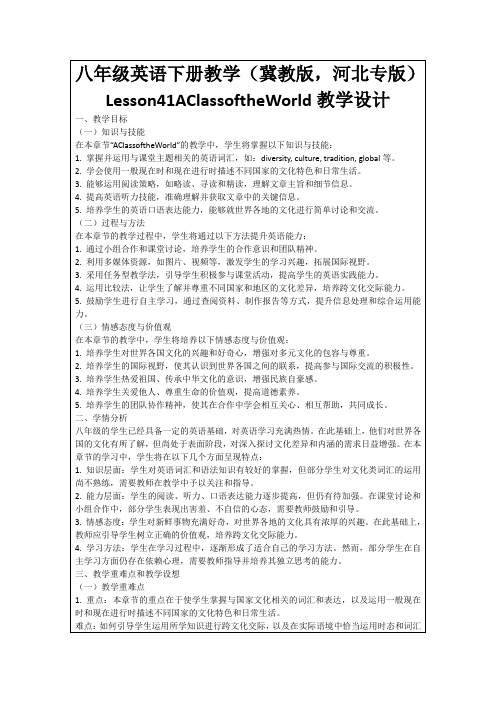
2.互动交流:采用小组合作和角色扮演等形式,组织学生进行课堂讨论,促进学生之间的互动交流,提高口语表达能力。
3.分层教学:针对不同学生的英语水平,设计不同难度的任务和活动,使每个学生都能在课堂上得到锻炼和提升。
4.拓展阅读:鼓励学生在课后阅读有关世界文化的英文文章,拓展知识面,提高阅读理解能力。
5.文化体验:组织学生参加学校或社区的文化体验活动,如国际文化节、外国文化讲座等,让学生在实践中感受世界文化的魅力。
5.视频观看:推荐学生观看一部关于其他国家文化的纪录片或电影,如《舌尖上的中国》、《地球脉动》等,让学生在轻松愉快的氛围中了解世界各地的风土人情。
6.家庭作业:布置学生完成课后练习册的相关题目,巩固课堂所学知识。
7.课后反思:要求学生反思本节课的学习过程,总结自己在学习中的优点和不足,并提出改进措施。
四、教学内容与过程
(一)导入新课
1.教师以一张世界地图作为课件背景,向学生展示不同国家的地理位置,引导学生关注世界各地的文化差异。
2.通过提问方式引导学生回顾已学过的关于不同国家文化的知识,为新课的学习做好铺垫。
3.创设情境:教师播放一段关于世界各国文化的视频,让学生在观看过程中感受世界文化的多样性,激发学生对新课的兴趣。
2.能力层面:学生的阅读、听力、口语表达能力逐步提高,但仍有待加强。在课堂讨论和小组合作中,部分学生表现出害羞、不自信的心态,需要教师鼓励和引导。
3.情感态度:学生对新鲜事物充满好奇,对世界各地的文化具有浓厚的兴趣。在此基础上,教师应引导学生树立正确的价值观,培养跨文化交际能力。
冀教版英语八年级下册教案(全册)

Unit 1Spring is Coming!Lesson 1: How’s the Weather ?(two periods)教案Teaching Content:Mastery words and expressions: rather, shower, rise, rose, risen, setOral words and expressions: thunder, storm, sunrise, sunsetTeaching Aims: Talking about the weatherTeaching Important Points:1.Describe the weather in spring;2.Talk about the temperature.Teaching Difficult Points:Describe the nature phenomenon.Teaching preparation: the pictures of springTeaching Aids: audiotape; flashcards; picturesType of lesson: new lessonTeaching Procedure:一、温故知新。
Check some words and phrases .二、激情导入。
Lead inFree talk:1.What weather do you like? Why or why not?2.What sports can you do in this season?三、新课学习。
Step 1: Showing the teaching aims on the blackboard and asking students to read them together.1.Remembering some new words and phrases of lesson 1 work in group.2.Talking about seasons.3.Understanding the dialogue meaning.Step2. Come to “THINK ABOUT IT”Let the students work in groups and answer the following questions:1.Look outside. Wh at’s the weather like today?2.How does this weather make you feel?Step3. Listen to the tape and answer the following questions:1.What’s the weather like today?2.It is snowing, isn’t it?3.what’s the temperature?4.Is it going to rain today, isn’t it?Step4. Read the text and check the answers. Read the text in roles.Step5. PracticeWork in three students. Suppose you are a weather reporter. Now report today’s weather to the others in your group. Then report it to the class. Step6. PracticeMake up a dialogue between two or three students in class. It is about the weather in spring. Let some students act it out before the class.四、达标训练,作业布置。
八年级英语下册教学(冀教版,河北专版)Lesson4TheSpringCity教学设计

1.抄写本节课的生词和短语,并翻译成中文。
2.ቤተ መጻሕፍቲ ባይዱ习本节课的主要句子,并用英语写一篇关于北京的小短文。
3.选择一个北京的历史文化景点,用英语介绍其背景、特点和参观后的感受。
作业的布置旨在让学生在课后复习和巩固所学知识,同时提高他们的写作和表达能力。对于不同程度的学生,作业的难度也有所区分,以满足他们的个性化学习需求。
2.教师提问:“你们对北京了解多少?”,让学生分享他们已知的关于北京的信息。
3.教师总结并引出本节课的学习目标:通过英语学习,进一步了解北京的历史和文化。
(二)讲授新知
1.教师引导学生学习本节课的生词和短语,如“spring city”、“capital”、“historical sites”等,并讲解其含义和用法。
八年级英语下册教学(冀教版,河北专版)Lesson4TheSpringCity教学设计
一、教学目标
(一)知识与技能
本节课是冀教版八年级英语下册的第四课,主题是“The Spring City”,主要介绍中国的首都北京。通过本节课的学习,学生能够掌握以下知识点:
1.能够听懂、会说、会读本节课的生词和短语,如“spring city”、“capital”、“historical sites”等。
在教学评价方面,教师采用形成性评价和终结性评价相结合的方式。形成性评价主要体现在课堂活动中,教师对学生的发音、语法、表达等方面进行即时点评,给予鼓励和建议。终结性评价主要体现在作业和课堂展示方面,教师对学生的作品进行详细点评,给出客观、公正的评价。
四、教学内容与过程
(一)导入新课
1.教师通过展示北京的图片和视频,激发学生的学习兴趣,引出本节课的主题“The Spring City”。
冀教版英语八年级下册Unit2:Lesson7PlantingTrees.教学设计

3.创意作业:鼓励学生设计一份关于植树节的海报,要求海报中包含植树的意义、环保口号、植树步骤等内容。学生可以充分发挥创意,运用色彩、图片等元素,使海报更具吸引力。
5.教学评价设想:
-采用形成性评价,关注学生在课堂上的参与程度和表现,及时给予反馈和鼓励。
-设计课后作业,如植树日记或环保行动计划,以巩固课堂所学,并了解学生对知识点的掌握情况。
-定期组织口语和写作测试,评估学生对词汇和语法结构的运用能力,以及他们对环保话题的理解深度。
四、教学内容与过程
(一)导入新课
2.创设真实情境,如模拟植树活动,让学生在角色扮演中练习使用一般现在时,描述植树的过程。通过这种互动性强的教学活动,提高学生的口语表达能力和听力理解能力。
3.设计小组合作任务,如编写关于植树的宣传册或小短剧,促进学生之间的交流与合作,同时锻炼他们的写作能力和团队协作能力。
4.引入案例分析,让学生探讨植树活动对环境保护的重要性,并结合实际情况,讨论如何在生活中实践环保行动,如节约用水、减少塑料使用等。
二、学情分析
针对冀教版英语八年级下册Unit2:Lesson7 Planting Trees这一章节,在进行教学设计前,需要对学生的学情进行分析。八年级的学生已经具备了一定的英语基础,掌握了基本的词汇和语法知识,但在实际应用中,他们的表达能力仍有待提高。此外,学生在学习过程中,对于环保、植树等话题已有初步的认识,但可能缺乏深入的了解和思考。
3.学生能够通过听力练习,提高英语听力水平,抓住关键信息,理解课文内容。
4.学生能够在口语交流中,运用所学句型和词汇,讨论植树的意义和环保问题。
初中英语冀教版八年级下册教案

初中英语冀教版八年级下册教案推荐文章八年级上册英语重要常考知识点热度:仁爱英语八年级下册期末试卷热度:仁爱英语八年级下册课文翻译2017 热度:外研版八年级上册英语教案热度:初中生八年级上册英语教学计划热度:英语教案本身所包括了教学组成部分、教师教学安排、教学手段与方法和教学时间等。
下面是小编为大家精心整理的初中英语冀教版八年级下册教案,仅供参考。
初中英语冀教版八年级下册教案范文Lesson 57: Let’s Clean Up!Teaching Content:Mastery words and expressions: yard, rubbish, pick up, bit, a bit of, bigOral words and expressions: garbage, pollution, finish doing, get to workTeaching Aims:1. Let the students understand to protect our environment is our duty.2. We should keep our school yard clean.Teaching Important Points:1. Know how many ways we can say “garbage”.2. Talk about the destroy of the rubbish.Teaching Difficult Points:Some words and expressions, such as: pick up, clean up Teaching Preparation: picturesTeaching Aids: audiotape, flashcards, picturesType of lesson: new lessonTeaching Procedure:Step1. Come to “TALK ABOUT IT.”Step2. Show the new words to the students. Let the students read the words first. Then let them read after the tape.Step3. Listen to the tape and do Exercise 3 in activity book. Step4. Read the text and check the answers silently. At the same time, answer the following questions:1. Where are Jenny, Brian and Danny?2. How’s the weather?3. What do English people call “rubbish”?4. What is Jenny studying in class this week?5. What does the teacher think of Jenny’s idea?Step5. Read the text in roles loudly. Then let some students act it out in front of the class.Step6. PracticeExplain some language points to the class. Then ask the students to make up sentences with them.1. But look at all of the rubbish!2. Somebody should pick up that garbage!3. It would take too long.4. Each student could clean up a bit of the school yard.5. We would finish cleaning in an hour.Step7. Come to “LET’S DO IT.”Work in teams with three or four people. Let some students act their dialogue out in front of the class.Step 8. Homework1. Finish off the exercises in activity book.2. Go on the next reading in the student book.Summary:This lesson is close to our life. Try to take the students out of the classroom and show the garbage to them. Then let them saywhat they feel about the garbage. Ask them to act the dialogue out in the school yard. 冀教版英语八年级下册第八单元教案Lesson 57: Let’s Clean Up!Teaching Content:Mastery words and expressions: yard, rubbish, pick up, bit, a bit of, bigOral words and expressions: garbage, pollution, finish doing, get to workTeaching Aims:1. Let the students understand to protect our environment is our duty.2. We should keep our school yard clean.Teaching Important Points:1. Know how many ways we can say “garbage”.2. Talk about the destroy of the rubbish.Teaching Difficult Points:Some words and expressions, such as: pick up, clean up Teaching Preparation: picturesTeaching Aids: audiotape, flashcards, picturesType of lesson: new lessonTeaching Procedure:Step1. Come to “TALK ABOUT IT.”Step2. Show the new words to the students. Let the students read the words first. Then let them read after the tape.Step3. Listen to the tape and do Exercise 3 in activity book. Step4. Read the text and check the answers silently. At the same time, answer the following questions:1. Where are Jenny, Brian and Danny?2. How’s the weather?3. What do English people call “rubbish”?4. What is Jenny studying in class this week?5. What does the teacher think of Jenny’s idea?Step5. Read the text in roles loudly. Then let some students act it out in front of the class.Step6. PracticeExplain some language points to the class. Then ask the students to make up sentences with them.1. But look at all of the rubbish!2. Somebody should pick up that garbage!3. It would take too long.4. Each student could clean up a bit of the school yard.5. We would finish cleaning in an hour.Step7. Come to “LET’S DO IT.”Work in teams with three or four people. Let some students act their dialogue out in front of the class.Step 8. Homework1. Finish off the exercises in activity book.2. Go on the next reading in the student book.Summary:This lesson is close to our life. Try to take the students out of the classroom and show the garbage to them. Then let them say what they feel about the garbage. Ask them to act the dialogue out in the school yard.八年级英语复习题完型填空(10分)阅读下面短文,根据短文内容从每小题A、B、C、D中选出能填入空白处的最佳答案。
八年级英语下册教学(冀教版,河北专版)Lesson34ModernOlympics教学设计

d.口语教学:设计角色扮演、小组讨论等活动,让学生在实际交流中运用所学知识,提高口语表达能力。
3.情感教育:结合奥运会的背景,引入我国在奥运会上的辉煌成就,激发学生的民族自豪感,引导学生树立正确的价值观。
4.作业设计:
1.学生在语言表达方面,词汇量和句型掌握程度有限,需要教师在课堂上进行针对性指导,帮助学生拓展词汇和句型,提高口语表达能力。
2.学生的阅读理解能力有待提高,教师应引导学生掌握阅读技巧,提高阅读效率,从而更好地理解文章内容。
3.学生对于奥运会的情感认同感较强,教师可以充分利用这一点,激发学生的学习兴趣,引导他们关注国家体育事业的发展。
(二)讲授新知
1.教学内容:教师以课文为基础,讲解以下知识点:
a.新词汇:Olympic Games, revive, symbol, torch, parade, host, gymnastics, track and field, swimming等。
b.语法:一般现在时和一般过去时的运用。
c.阅读策略:快速阅读、扫读、精读等。
2.针对不同学生的特点和水平,给予个性化的指导和建议。
3.鼓励学生积极参与作业完成,培养自主学习能力和合作精神。
2.练习方法:学生独立完成练习题,教师巡回指导,解答学生疑问。
3.评价方式:教师对学生的练习成果进行点评,给予鼓励和指导。
(五)总结归纳
1.教学内容:教师带领学生回顾本节课所学的新词汇、语法、阅读策略等知识点。
2.学生分享:学生分享自己在本节课的收获,包括知识、技能和情感态度方面的成长。
3.教师总结:教师对本节课的教学内容进行总结,强调重点和难点,布置课后作业。
八年级英语下册教学(冀教版,河北专版)Lesson1How‘stheWeather优秀教学案例

(三)情感态度与价值观
1.通过本节课的学习,培养学生对天气话题的兴趣,激发他们学习英语的积极性。
2.培养学生关爱生活,关注环境的情怀,教育他们学会描述和应对不同天气状况。
3.通过对天气话题的讨论,培养学生与人合作、分享的良好品质。
3.教授句型"How's the weather?"的用法,并进行口语练习。
4.设计听力练习,让学生听懂并回答与天气相关的问题,提高听力理解能力。
(三)学生小组讨论
1.组织学生进行小组讨论,分享自己喜欢的天气,并运用所学知识进行描述。
2.设计小组活动,让学生共同完成weather-related任务,如:编写天气相关的短剧,进行小组表演。
4.反思与评价:在教学过程中,我注重引导学生进行自我反思和同伴评价。学生能够通过反思总结自己在学习中的优点和不足,并通过同伴评价相互鼓励和共同进步。这有助于提高学生的自我认知和自我调整能力。
5.作业小结:我布置了一项与天气相关的写作作业,要求学生运用所学知识写一篇关于自己喜欢的天气的短文。这样的作业不仅能够巩固所学知识,还能够培养学生的写作能力和创造力。同时,我鼓励学生在课后进行weather-related话题的讨论和交流,以进一步巩固所学知识,并将所学知识应用到实际生活中。
4.引导学生正确对待生活中的各种天气,树立积极乐观的生活态度。
5.通过对天气话题的学习,培养学生跨文化交流的意识,提高他们的英语综合素质。
三、教学策略
(一)情景创设
1.利用多媒体展示不同天气的图片,如阳光明媚、阴雨绵绵等,引发学生对天气话题的兴趣。
2.结合生活实际,创设各种天气情境,让学生在真实环境中感受和描述天气。
八年级英语下册教学(冀教版,河北专版)Lesson2It'sGettingWarmer!优秀教学案例
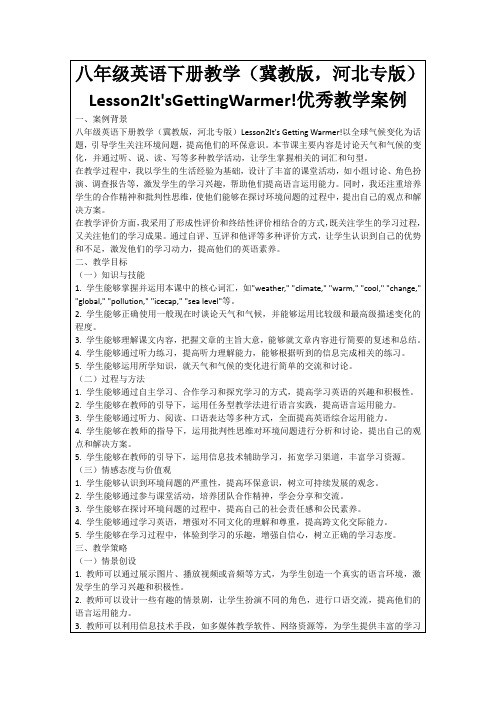
4.反思与评价的培养:教师鼓励学生在学习过程中进行自我反思,发现自己的优势和不足,制定相应的学习策略。同时,教师还组织学生进行互评和他评,让学生从不同的角度了解自己的表现,提高他们的自我评价能力和批判性思维。
4.教师可以对学生的学习过程和成果进行记录和总结,为学生提供全面、客观的评价,促进他们的全面发展。
四、教学内容与过程
(一)导入新课
1.教师可以通过展示一些与环境变化相关的图片或视频,如全球变暖、海平面上升等,引起学生的兴趣和关注。
2.教师可以提出一些引导性问题,如“你们有没有注意到天气和气候的变化?”、“你们认为是什么原因导致了这些变化?”等,激发学生思考和讨论。
(三)情感态度与价值观
1.学生能够认识到环境问题的严重性,提高环保意识,树立可持续发展的观念。
2.学生能够通过参与课堂活动,培养团队合作精神,学会分享和交流。
3.学生能够在探讨环境问题的过程中,提高自己的社会责任感和公民素养。
4.学生能够通过学习英语,增强对不同文化的理解和尊重,提高跨文化交际能力。
3.教师可以对学生的表现进行评价和反馈,鼓励他们继续努力。
(五)作业小结
1.教师可以布置一些与环境变化相关的作业,如写一篇关于环保的文章、做一个关于气候变化的调查报告等,让学生进行深入研究和思考。
2.教师可以要求学生在作业中运用所学知识和表达方式,提高他们的语言运用能力。
3.教师可以对学生的作业进行批改和评价,及时给予反馈,指导学生的学习。
3.学生能够理解课文内容,把握文章的主旨大意,能够就文章内容进行简要的复述和总结。
全新冀教版八年级英语下册教案(全册 共114页)

全新冀教版八年级英语下册教案(全册共114页)目录Unit 1 Spring is coming! Array Lesson 1 How’s t he weather?Lesson 2 It’s getting warmer!Lesson 3 The sun is rising!Lesson 4 The Spring CityLesson 5 Babysitting on a Spring DayLesson 6 Stories about springUnit 2 Plant a PlantLesson 7 Planting treesLesson 8 Why are plants important?Lesson 9 Gardening with MaryLesson 10 Make your garden grow!Lesson 11 Amazing plantsLesson 12 Danny’s plantUnit 3 Animals are our friendsLesson 13 Danny’s big scareLesson 14 Amazing animalsLesson 15 The zoo is openLesson 16 The Bear EscapedLesson 17 Save the tigersLesson 18 Friendship between animalsUnit 4 The Internet Connects UsLesson 19 How Do You Use the Internet?Lesson 20 A computer helpsLesson 21 Books or computers?Lesson 22 Travel on the InternetLesson 23 The Internet-Good or Bad?Lesson 24 An Email to GrandpaUnit 5 Buying and SellingLesson 25: Raising MoneyLesson 26 Cookies, Please!Lesson 27 Business EnglishLesson 28 Ms. Liu’s Great IdeaUnit 1 Spring is coming!Lesson 1 How’s the weather?◆教材分析本节课是冀教版初中英语八年级下册第一单元lesson1,功能话题是谈论天气;文本结构是对话;语法重点是初步认识合成词,并能够运用将来时态预测天气,以及正确使用will写简短的天气预报。
冀教版英语八年级下册14课教案

冀教版英语八年级下册14课教案冀教版英语八班级下册14课教案1教学目标一、知识与技能1. 掌握重点词汇和短语。
2. 培育学生的阅读能力及技巧。
3. 复习、运用过去进行时。
二、过程与方法训练法,熟能生巧法,通过练习巩固复习所学知识。
三、情感态度与价值观培育学生在灾害面前要更团结,更友善,更懂得互相帮助。
教学重点1. 掌握重点词汇和短语。
2. 复习、运用过去进行时。
教学难点1. 培育学生的阅读能力及技巧。
2. when和while的区别。
教法导航老师引导,学生自主探究,小组合作。
学法导航自主探究与小组合作相结合。
教学准备多媒体。
教学过程Step 1 GreetingsGreet the students as usual.Step 2 RevisionAsk students to talk about what they were doing last night in groups of four then give a report.Step 3 PresentationAsk the students to look at the picture and think about what has happened.Step 4 Reading3a, Read the passage quickly and answer the following questions1. What was the weather like before the heavy rain started?2. What was the neighborhood like after the storm?Ask some students to report their answers.3b, Read the passage again and complete the sentences using information from the passage.1. When the news on TV was reported,strong winds _____________ outside.2. While Ben’s mom was making sure the radio was working,his dad_____________.3. Ben _____________________ when the heavy rain finally started.4. When Ben _______________at 3:00 a.m.,the wind _________________.Ask some students to report their answers.Step 5 Speaking3c, Discuss the questions with a partner.“Although the storm broke many things apart,it brought families and neighbors closer together.”What other can bring people closer together? How can we help each other in times of difficulty?Ask some students to report their answers.Step 6 Language points1. With no light outside,it felt like midnight.此句中介词with表示一种伴随状况,同时还包含着某种因果关系,表示“因某种状况的存在而导致…”,因此可翻译成“由于;因为”等。
冀教版新课标八年级英语下册教案

冀教版新课标八年级英语下册教案英语教案的教学设计直接决定了是否能够上好一节英语课,下面是小编为大家精心整理的冀教版新课标八年级英语下册教案,仅供参考。
冀教版新课标八年级英语下册教案范文一、教材依据: Unit1: Spring is coming!Lesson 4: The Spring City二、教材分析:本单元围绕春天展开中心话题,描述了春天的天气和户外活动,加强了同学们对异国文化的了解和对祖国文化的热爱提高了学生学习英语的兴趣。
三、学情分析:现在初二的学生对于英语学习应该具有一定的基础和方法,但我们所处在山区农村中学,从初一才开始接触英语,所以对于英语的学习还没有掌握好的方法,学生在学习中还存在许多问题。
对于所学句子还不能在平时灵活运用,所以课堂中老师应尽可能多的运用多种教学方法来引导学生学习。
四、教学目标:1、知识与技能目标掌握本课的单词,了解春城——昆明的美景,并能在听听录音时,有目的的获取所需关键信息。
2、过程与方法目标通过听录音,自读及小组合作的方法学习课文,让学生热爱春天,热爱大自然!3、情感态度与价值观能通过谈论春天的天气,温度,空气和植物,让学生了解春天,热爱春天,了解异国文化和祖国文化的差异,拥抱大自然!五、教学重难点1、单词2、短语及语法六、教法与学法小组讨论、合作探究、教师指导七、课型新授八、教学过程Step 1.Lead-inA warming-upA sayingStep 2.pictures show and new words, then, listeningShow some pictures about spring and learn the new words by playing a game, the do the listening about the text and answer one simple question.What is the spring city?It’s Kunming.Step 3.ReadingAsk several students to read the text and pay attention to the new words, the students read it again, and discuss together about the four questions in “Let’s Do It.part1”Step 4. ListeningDo the listening in “Let’s Do It!”part2, listen to it twice, and then invite some students to answer them.Step 5.DiscussingDivide the class into small groups; write the following words on the blackboard:Air /weather/ plants/ and outdoor activities.Step nguage points1. feel like /sound like / smell like / taste likefeel like doing sth.2. because and because ofBecause +句子Because of + n./pron./doing3. hundreds of /基数词+单位名词(hundred /thousand/million/billion)4. think of =consider5. all over the world =around the world6. all year round7. plenty of=a lot of =lots of8. long for= look forward toStep 6.Homework1、Write a short passage about spring in your hometown2、Preview Lesson 5Step 7.Summary:Review the text is very important. The students know what they will take to the class, what is useful to the study. Let them to talk about The Spring City. --- Its air, weather, plants and the outdoor activities in spring.九、板书设计:Lesson 4: The Spring CityAir weather plants and the outdoor activities十、教学反思:本节课在前几节课学习的基础上进一步来学习春天,通过运用多媒体向学生展示了春天的景色。
八年级英语下册教学(冀教版,河北专版)Lesson2It'sGettingWarmer!教学设计
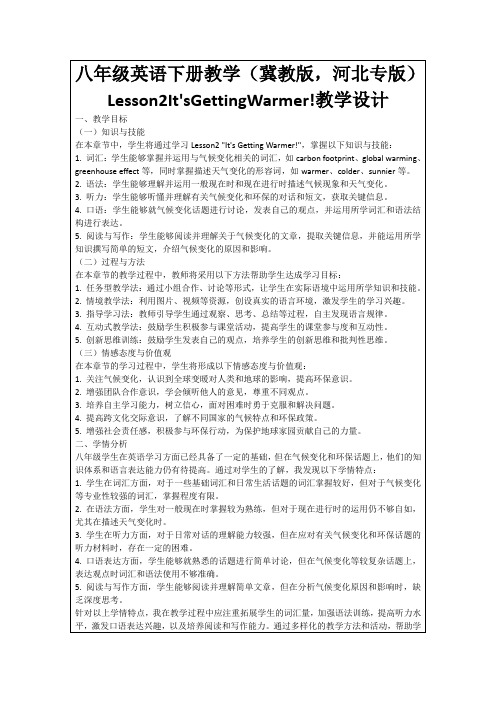
2.在语法方面,学生对一般现在时掌握较为熟练,但对于现在进行时的运用仍不够自如,尤其在描述天气变化时。
3.学生在听力方面,对于日常对话的理解能力较强,但在应对有关气候变化和环保话题的听力材料时,存在一定的困难。
3.教师强调气候变化对人类和地球的重要性,呼吁学生关注环保,为保护地球家园贡献自己的力量。
4.布置课后作业,要求学生运用所学知识,撰写一篇关于气候变化的短文,巩固所学成果。
五、作业布置
为了巩固本节课的学习成果,确保学生对气候变化话题的理解和运用能力得到提升,特布置以下作业:
1.词汇积累:请学生整理本节课所学的气候变化相关词汇,并查找至少三个额外的相关词汇,要求写出单词、词性、中文意思,并造一个句子展示其用法。
2.学生分享自己的观察和想法,教师适时引导,将话题引入到本课的主题:“It's Getting Warmer!”。
3.教师播放一段关于全球变暖的短视频,让学生了解全球变暖对地球和人类生活的影响,为后续学习做好铺垫。
(二)讲授新知,500字
1.教师带领学生学习本课的词汇,如carbon footprint、global warming、greenhouse effect等,通过例句、图片等形式帮助学生理解和记忆。
三、教学重难点和教学设想
(一)教学重难点
1.词汇:气候变化相关的专业词汇,如carbon footprint、global warming、greenhouse effect等,以及描述天气变化的形容词,如warmer、colder、sunnier等。
2.语法:现在进行时在描述气候变化和天气状况中的应用。
八年级英语下册教学(冀教版,河北专版)Lesson31Don'tFall,Danny教学设计

1.教师设计一份听力练习,让学生听懂并选择正确的答案,检测他们对听力材料的理解程度。
2.教师给出几个场景,让学生运用一般现在时和祈使句进行口语练习,如:“When you play basketball, you should keep your eyes on the ball and don't forget to catch it.”
3.教师讲解一般现在时和祈使句的用法,结合课文中的句子,让学生理解和掌握这两种句型的表达方式。
4.教师通过问答、替换练习等形式,帮助学生巩固新学的词汇和句型。
(三)学生小组讨论
1.教师将学生分成小组,让他们讨论以下问题:“How can we keep balance? What exercises can help us improve our strength and flexibility?”
3.能够理解并运用关于运动、健康和安全的词汇和句型,如:“You should do exercise to improve your balance.”、“Be careful not to fall.”等。
4.提高英语听力水平,能够理解故事情节,获取关键信息。
5.提高英语口语表达能力,能在小组活动中讨论运动和健康话题。
3.教师挑选几个学生进行角色扮演,模拟课文中的对话,提高学生的口语表达能力。
(五)总结归纳
1.教师引导学生回顾本节课所学的新词汇、短语、句型以及一般现在时和祈使句的用法。
2.教师强调运动对健康的重要性,提醒学生在运动过程中注意安全。
3.教师对本节课学生的表现进行评价,鼓励他们继续努力,提高英语水平。
2.培养学生的安全意识,学会在运动过程中保护自己。
冀教版英语教学设计八下
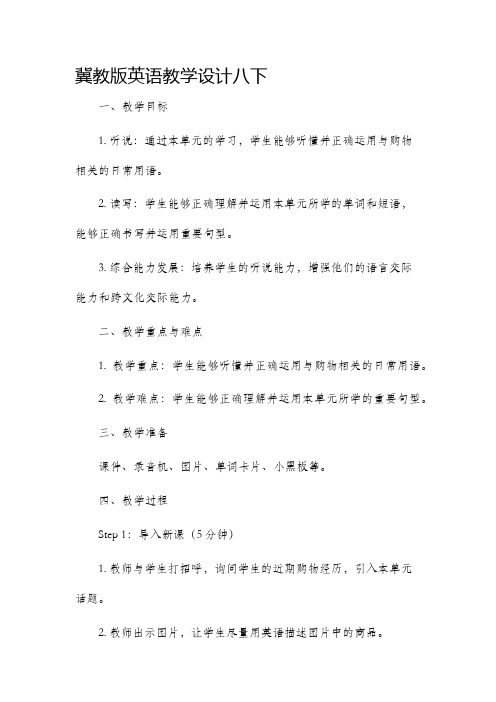
冀教版英语教学设计八下一、教学目标1. 听说:通过本单元的学习,学生能够听懂并正确运用与购物相关的日常用语。
2. 读写:学生能够正确理解并运用本单元所学的单词和短语,能够正确书写并运用重要句型。
3. 综合能力发展:培养学生的听说能力,增强他们的语言交际能力和跨文化交际能力。
二、教学重点与难点1. 教学重点:学生能够听懂并正确运用与购物相关的日常用语。
2. 教学难点:学生能够正确理解并运用本单元所学的重要句型。
三、教学准备课件、录音机、图片、单词卡片、小黑板等。
四、教学过程Step 1:导入新课(5分钟)1. 教师与学生打招呼,询问学生的近期购物经历,引入本单元话题。
2. 教师出示图片,让学生尽量用英语描述图片中的商品。
Step 2:新课学习(30分钟)1. 听力训练(1)播放录音,让学生听一段对话,理解并回答相关问题。
(2)教师与学生一起复习并运用对话中的日常用语,如“How much is this?”等。
2. 词汇学习(1)教师出示单词卡片,引导学生认读单词,并进行拼写和发音练习。
(2)师生一起讨论单词的义项,并进行词语搭配练习。
3. 句型学习(1)教师出示重要句型,通过示范和让学生模仿的方式学习句型的用法。
(2)学生们进行角色扮演,使用所学句型进行购物对话练习。
Step 3:听力训练(15分钟)1. 教师播放录音,学生们仔细倾听并完成听力练习。
2. 学生们模仿录音中的对话进行朗读,加强语音语调训练。
Step 4:拓展活动(20分钟)1. 听力巩固练习教师设计一系列购物场景,播放录音让学生们根据录音内容选择正确的答案。
2. 角色扮演学生们分成小组进行角色扮演,模拟真实的购物情景对话,并进行表演。
Step 5:作业布置(5分钟)1. 词汇练习:学生们完成课后练习册中与本单元词汇相关的练习。
2. 写作训练:学生们写一篇关于自己购物经历的短文。
五、教学反思在这堂课中,我充分利用了多媒体和互动的教学手段,使学生更好地参与到课堂中,提高了他们的学习兴趣。
全新冀教版八年级英语下册教案(全册 共155页)
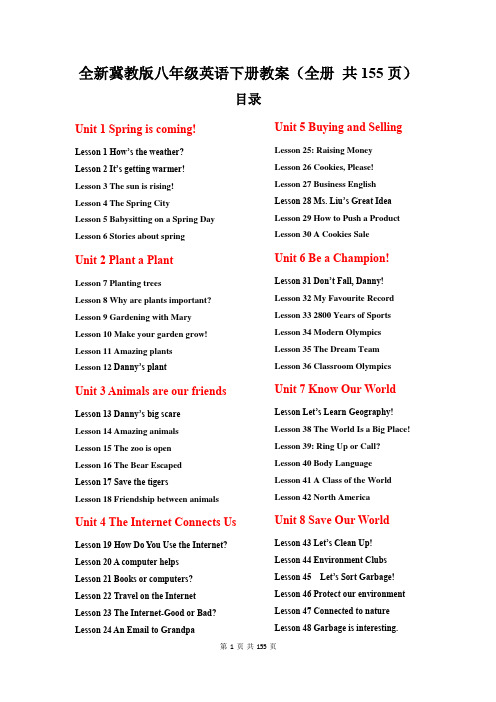
全新冀教版八年级英语下册教案(全册共155页)目录Unit 1 Spring is coming!Lesson 1 How’s the weather?Lesson 2 It’s getting warmer!Lesson 3 The sun is rising!Lesson 4 The Spring CityLesson 5 Babysitting on a Spring Day Lesson 6 Stories about springUnit 2 Plant a PlantLesson 7 Planting treesLesson 8 Why are plants important? Lesson 9 Gardening with MaryLesson 10 Make your garden grow! Lesson 11 Amazing plantsLesson 12 Danny’s plantUnit 3 Animals are our friends Lesson 13 Danny’s big scareLesson 14 Amazing animalsLesson 15 The zoo is openLesson 16 The Bear EscapedLesson 17 Save the tigersLesson 18 Friendship between animals Unit 4 The Internet Connects Us Lesson 19 How Do You Use the Internet? Lesson 20 A computer helpsLesson 21 Books or computers?Lesson 22 Travel on the InternetLesson 23 The Internet-Good or Bad? Lesson 24 An Email to Grandpa Unit 5 Buying and Selling Lesson 25: Raising MoneyLesson 26 Cookies, Please!Lesson 27 Business English Lesson 28 Ms. Liu’s Great Idea Lesson 29 How to Push a Product Lesson 30 A Cookies SaleUnit 6 Be a Champion! Lesson 31 Don’t Fall, Danny! Lesson 32 My Favourite Record Lesson 33 2800 Years of Sports Lesson 34 Modern Olympics Lesson 35 The Dream Team Lesson 36 Classroom Olympics Unit 7 Know Our World Lesson Let’s Learn Geography! Lesson 38 The World Is a Big Place! Lesson 39: Ring Up or Call? Lesson 40 Body LanguageLesson 41 A Class of the World Lesson 42 North AmericaUnit 8 Save Our World Lesson 43 Let’s Clean Up!Lesson 44 Environment Clubs Lesson 45 Let’s Sort Garbage! Lesson 46 Protect our environment Lesson 47 Connected to nature Lesson 48 Garbage is interesting.Unit 1 Spring is coming!Lesson 1 How’s the weather?◆教材分析本节课是冀教版初中英语八年级下册第一单元lesson1,功能话题是谈论天气;文本结构是对话;语法重点是初步认识合成词,并能够运用将来时态预测天气,以及正确使用will写简短的天气预报。
冀教版八年级英语下册Lesson2教学设计
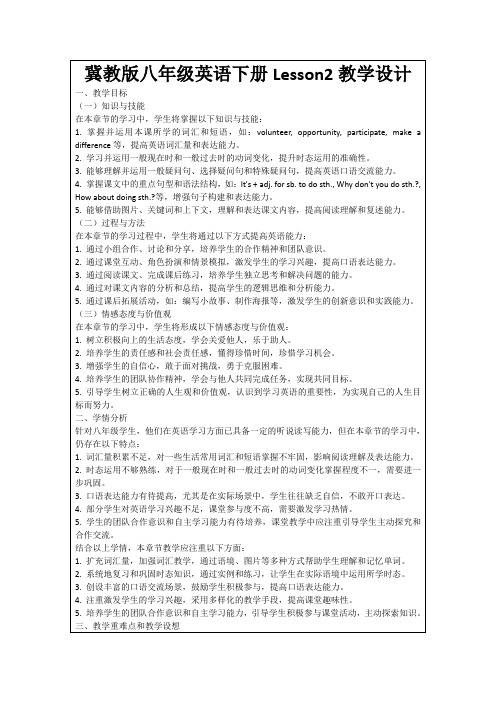
1.教师引导学生回顾本节课所学的内容,总结一般现在时和一般过去时的动词变化、疑问句的用法等知识点。
2.学生分享学习收获,教师对学生的发言进行点评和补充。
3.教师强调本节课的情感态度与价值观目标,引导学生认识到志愿活动的重要性,激发学生的社会责任感。
4.教师布置课后作业,要求学生运用所学知识编写一个小故事,描述一次志愿活动,进一步巩固课堂所学。
-创设多样化的口语交流场景,如角色扮演、情景模拟等,让学生在实际场景中练习口语表达。
-鼓励学生大胆开口,给予积极评价,增强学生的自信心。
-开展课堂讨论、小组合作等活动,培养学生的团队协作能力和口语表达能力。
4.情感态度培养:
-结合课文内容,引导学生思考并讨论积极向上的生活态度。
-创设情境,让学生在角色扮演中体验情感态度的转变。
五、作业布置
为了巩固本章节所学知识,提高学生的英语综合运用能力,特布置以下作业:
1.完成课后练习题:请学生完成课本中与本课相关的练习题,以巩固词汇、短语和语法知识,提高阅读理解能力。
-填空题:填入适当的词汇,使句子完整、通顺。
-选择题:从四个选项中选择正确的答案,锻炼学生的判断和推理能力。
-改写句子:运用所学时态和句型,对句子进行改写,提高表达能力。
5.培养学生的团队合作意识和自主学习能力,引导学生积极参与课堂活动,主动探索知识。
三、教学重难点和教学设想
(一)教学重难点
1.词汇和短语的掌握:本章节涉及的词汇和短语如volunteer, opportunity, participate等,是学生需要重点掌握的语言知识,同时也是学习的难点。
2.时态的运用:一般现在时和一般过去时的动词变化在课文中的灵活运用,对于学生来说是一个挑战,需要通过大量的练习来巩固。
八年级英语下册教学(冀教版,河北专版)Lesson26Cookies,Please!优秀教学案例

1.引导学生提出问题,激发他们的思考和探究欲望。
2.通过思考题和讨论题,让学生深入理解食物的特点和喜好。
3.鼓励学生自主探究,培养他们的批判性思维能力。
在教学过程中,我运用问题导向策略,引导学生提出问题,激发他们的思考和探究欲望。通过设计一系列思考题和讨论题,让学生深入理解食物的特点和喜好,培养他们的批判性思维能力。同时,鼓励学生自主探究,让他们在解决问题的过程中,提高自己的思维能力和解决问题的能力。
2.学生能够通过小组讨论和合作,培养自主学习和合作学习能力。
3.学生能够通过口语表达和写作,运用所学知识进行实际交流。
在教学过程中,我注重引导学生通过观察、阅读、讨论和合作等方法,积极主动地参与到学习过程中。通过设计具有挑战性和趣味性的教学活动,激发学生的学习兴趣,培养他们的自主学习和合作学习能力。
作为一名特级教师,我深知教学内容与过程的重要性。在教学过程中,我注重导入新课的趣味性,讲授新知的清晰度,学生小组讨论的参与度,总结归纳的深度以及作业小结的实用性。通过这些教学内容与过程的设计,我能够激发学生的学习兴趣,培养他们的自主学习能力、合作能力和口语表达能力。我相信,通过这样的教学方式,学生将能够在英语学习中取得更好的成绩,并为未来的学习和发展打下坚实的基础。
(四)总结归纳
1.让学生总结一般现在时的被动语态的用法和构成。
2.引导学生归纳食物的特点和喜好,加深他们对知识的理解。
在总结归纳环节,我让学生自主总结一般现在时的被动语态的用法和构成,加深他们对知识的理解。同时,我引导学生归纳食物的特点和喜好,帮助他们巩固所学内容。通过总结归纳,学生能够更好地梳理知识体系,提高学习效果。
在教学过程中,我注重引导学生主动参与,鼓励他们积极表达自己的观点,培养他们的自主学习和合作学习能力。同时,我通过人性化的教学语言和鼓励性的评价,激发学生的学习兴趣和自信心,让他们在轻松愉快的氛围中学习英语。
八年级英语下册教学(冀教版,河北专版)Lesson13Danny'sBigScare教学设计

3.能够理解并运用本课中所学的常用句型,如:“I was so scared that...”, “I thought that...”, “It turned out that...”等进行情景对话和故事叙述。
4.提高英语听力理解能力,能够理解并获取课文中关键信息,如:故事情节、人物情感等。
(二)讲授新知
在讲授新知环节,我会以故事的形式呈现课文内容,让学生在情境中学习一般过去时态和核心词汇。
首先,我会带领学生一起阅读课文,并讲解一般过去时态的构成和用法。针对动词过去式的变化规则,我会通过例句和练习进行详细讲解,帮助学生掌握。
接着,我会对核心词汇和短语进行讲解,结合课文中的语境,让学生在实际应用中理解和记忆。同时,通过板书和多媒体展示,强化学生对词汇的认知。
3.活动设计:
-听力训练:播放课文录音,让学生跟读并回答相关问题,提高听力理解能力。
-口语练习:组织角色扮演活动,让学生模仿故事中的对话,练习一般过去时态的口语表达。
-小组讨论:让学生讨论故事中丹尼的经历,分享自己类似的经历,培养情感共鸣。
4.巩固拓展:
-设计填空、改错等书面练习,巩固学生对一般过去时态的掌握。
此外,我会告知学生,在完成作业过程中遇到问题时,可通过线上或线下的方式向我请教,确保学生在学习过程中得到及时的帮助和指导。通过这样的作业布置,使学生在课后能够有效地巩固所学知识,提高英语综合运用能力。
八年级英语下册教学(冀教版,河北专版)Lesson13Danny'sBigScare教学设计
一、教学目标
(一)知识与技能
在本章节的学习中,学生将掌握以下知识与技能:
1.掌握并运用本课的核心词汇和短语,如:scare, ghost, haunted house, bravery, courage等,并能运用这些词汇进行简单的描述和表达。
- 1、下载文档前请自行甄别文档内容的完整性,平台不提供额外的编辑、内容补充、找答案等附加服务。
- 2、"仅部分预览"的文档,不可在线预览部分如存在完整性等问题,可反馈申请退款(可完整预览的文档不适用该条件!)。
- 3、如文档侵犯您的权益,请联系客服反馈,我们会尽快为您处理(人工客服工作时间:9:00-18:30)。
冀教版英语八年级下册教案Lesson 1: What’s the Weather Like?Teaching Content:Mastery words and expressions: rather, shower, rise, rose, risen, setOral words and expressions: thunder, storm, sunrise, sunsetTeaching Aims:Talking about weatherTeaching Important Points:1.Describe the weather in spring;2.Talk about the temperature.Teaching Difficult Points:Describe the nature phenomenon.Teaching preparation: the pictures of springTeaching Aids: audiotape; flashcards; picturesType of lesson: new lessonTeaching Procedure:Step1. Free talk1.What weather do you like? Why or why not?2.What sports can you do in this season?Step2. Come to “THINK ABOUT IT”Let the students work in groups and answer the following questions:1.Look outside. Wha t’s the weather like today?2.How does this weather make you feel?Step3. Listen to the tape and answer the following questions:1.What’s the weather like today?2.It is snowing, isn’t it?3.what’s the temperature?4.is i t going to rain today, isn’t it?Step4. Read the text and check the answers. Read the text in roles.Step5. PracticeWork in three students. Suppose you are a weather reporter. Now report today’s weather to the others in your group. Then report it to the class.Step6. PracticeMake up a dialogue between two or three students in class. It is about the weather in spring. Let some students act it out before the class.Step7. Homework1.Find something that represents spring and show it to the class next time.2.Finish off the activity book.Lesson 2: It’s Getting Warmer!Teaching Content:Mastery words and expressions: become, became, become, factOral words and expressions: daylight, melt, lightning, fascinatingTeaching Aim:1.Know something more about spring;2.The compound words.Teaching Important Points:1.When does spring begin?2.How many hours of daylight are there on March 21st?3.What is the weather like?Teaching Difficult Points:the compound wordsTeaching Preparation: some pictures of springTeaching Aids: audiotape, flashcards, some picturesType of lesson: new lessonTeaching Procedure:Step1. Let the students on duty reports the weather to the class. The others listen and decide it is right or wrong.Step2. Listen to the tape and answer the following questions:1.What’s the date today?2.How many ways can you write dates?3.How many hours of daylight are there on March 21st?4.What is spring weather like?5.What is the temperature of the air near lighting?Step3. Read the text and check the answers.Step4. Listen to the tape again and imitate after it until they can read it fluently and correctly. Step5. Ask the students to ask other questions according to the text. You can begin like this:1.When does the sun rise in the morning and when does it set in the evening?2.Does it snow in early spring?3.What is sometimes with thunder and lighting?Step6. Come to “LET’S DO IT”.Work in groups and discuss these questions. Then let them report it to the class.Step7. Homework1.Finish off the activity book.2.Write a composition about spring.Summary:We are enjoying spring now. We can feel it is warmer than before. But not all of us know when the sun rises in the morning and sets in the evening. Let the students observe after class, write it down and report it to the class. It can cultivate the students’ interests of learning English.Lesson 3: Postcards!Teaching Content:Mastery words and expressions: roadOral words and expressions: outdoorsTeaching Aim:1.Grasp how to write a letter and the address.2.Know more about the spring in China and Canada.Teaching Important Points:1. Find the differences between China and Canada in spring.3.Find the differences between the clothes that we wear in winter and in spring.Teaching Difficult Points:1.What’s the weather like in Edmonton?2.How to express one’s idea easily in a letter?Teaching Preparation: a postcardTeaching Aids: audiotape, flashcards, postcardsType of lesson: new lessonTeaching Procedure:Step1. Free TalkLet the students work in three and talk about the sports that we often do in spring. Then give a talk for the class.Step2. Have a matchRead the text and see who read it best. Remember to encourage the students who preview the new lesson.Step3. Listen to the tape and read after it. Play the tape for several times until they can read it fluently and correctly.Step4. Ask the students to find questions and solve them. They can ask the questions like this:1.How did Li Ming go to school on March twenty-first?2.What’s the temperature that afternoon?3.What time does the sun rise this morning?4.Is it snowing in Canada?5.When does it often snow in winter?6.Did Danny fall in the snow?Step5. Come to “THINK ABOUT IT”Write a postcard to your friend to introduce the weather here. Then write the address and stick a stamp on it. Mail it in the post office.Step6. Homework1.Finish off the activity book.2.Listen to the song in Lesson 4.Summary:Written English is an important part in English learning. Practice is the key to it. Do they have the spelling mistakes or the grammar mistakes in the writing? Find out and help them come over it. Pay more attention to the writing because it’s an important part of communication.Lesson 4: Sun Is RisingTeaching Content:Mastery words and expressions: one by one, changeOral words and expressions: hillside, gently, blossomTeaching Aim:Enjoy the beauty of the springTeaching Important Point:Grasp the changes that spring bring usTeaching Difficult Points:How to use “warm” and “gently”.Teaching Preparation: something that represents springTeaching Aids: audiotape, flashcards, pictures or flowersType of lesson: new lessonTeaching Procedure:Step1. Read the song aloud as a poem. This song has this song has common English words: come with me, through the trees, one by one, the flowers blossom. Translate these expressions into English.Step2. Play the audiotape and let the students just listen with the eye closed.Step3. Play the tape again and let the students sing with it.Step4. Explain the common English expressions.Step5. Practice the song a few times, with and without the audiotape.Step6. Come to “LET’S DO IT”.STEP7. Homework1.Finish off the activity book.2.Write down what you can see in spring.SummaryWe use this lesson to cultivate the students’ sense of enjoying English songs. Pay attention to the rhyme, rhythm and repetition in the song. Learning English songs is a little difficult from Chinese songs. Find the ways in which we can learn fast.Lesson 5: Fun in the SunTeaching Content:Mastery words and expressions: shall, kickOral words and expressions: cycling, How/What about…? Shall we…?Teaching Aims:How to enjoy oneself in spring.Teaching Important Points:1. the sports that we do in spring.2.some drills: How about…? Let’s…Teaching Difficult Points:How to advice sb. to do sth.Teaching Preparation: basketball and soccerTeaching Aids: audiotape, flashcards and ballsType of lesson: new lessonTeaching Procedure:Step1. Listen to the tape of Lesson4 again, then let’s sing the song together.Step2. Listen to the tape and answer the following questions:1.What’s the degree?2.What will Danny wear tomorrow?3.What will they do after school?4.Why don’t Danny like basketball?Step3. Read the text and check the answers. Then read the text again.Step4. Act the dialogue out in front of the class.Step5. Make up a similar dialogue according to the text. Let’s the students act it out in front of the class.Step6. Come to “PROJECT”.Divide the class into several groups. Write the answers down. Ask the several groups to change their answers.Step7. Homework1.Finish off the activity book.2.Review the last lesson.SummarySpring is a beautiful season. It’s the favourite season of many people. In this season, everything begins to turn green. Spring represents the beginning. We have many things to do in it. We can fly kites and play ball games. Running in the wind is what we like to do in our childhood. Lead your students to think hard what they like to do in this season. Let them talk freely in the class.Lesson 6. Danny the babysitterTeaching Content:Mastery words and expressions: playground, hold, hold on, come down, pushOral words and expressions: babysitter, babysit, Debbie, bar, swing, swungTeaching Aims:1.We should love each other.2.The duty of a babysitterTeaching Important Points:1.How to demonstrate one thing clearly.3.Cultivate the spirit of loving each other. Let’s love life and peace.Teaching Difficult Points:Some verb phrases: turn around, hold on, fall off, run to, come down, climb on, give sb. a push Teaching Aids: audiotape, flashcards, picturesType of lesson: new lessonTeaching Procedure:Step1. Work in pairs. Tell your partner what you did after school yesterday. The teacher walks around to provide help if necessary.Step2. Skim the text and ask questions by the students themselves. Then solve them by themselves, too. Let some students write their questions on the blackboard. Then let others answer them.Step3. Listen to the tape and read after it until they can read it correctly and fluently.Step4. Ask some students to come to the front and act it out. Pay attention to who is clever enough to add something new.Step5. Retell the story in a third person.Step6. Come to “THINK ABOUT IT”.In a group of three, make up a “babysitting” role-play. Ask volunteers to act it out. Then it’s the other students’ turn.Step7. Homework1.Finish off the activity book.2.suppose one day, you become a babysitter, what will you do?SummaryWhen we practice in the class, don’t forget to give chances to the poor students. When they have a little progress, encourage them to work hard. That’s what a good teacher should do.Lesson 7: Danny’s “Debbie” DayTeaching Content:Mastery words and expressions: herselfOral words and expressions: partly, all dayTeaching Aims:1.Learn to write a diary.2.What do we write in a diary.Teaching Important Points:When we are babysitters, what can we do?Teaching Difficult Points: the Past TenseTeaching Preparation: some toysTeaching Aids: audiotape, flashcards, some toysType of lesson: new lessonTeaching Procedure:Step1. Work in groups. Retell Lesson 6 in Past Tense in a third person.Step2. Read the text silently by students themselves. Then answer the questions in the activity. Check the answers in the class.Step3. Listen to the tape and read after it. Some students may think it is easy to listen with the book. Then listen to the tape again with the book closed. At the same time, the teacher asks some students to repeat some sentences to see if they can listen clearly.Step4. Let some students read the text aloud in front of the class. Let’s have a match. Who can read it fast and correctly?Step5. PracticeWork in groups. Write down experience that you have ever been a babysitter. Do you think it easy to be a babysitter? Why or why not?Step6. Come to “LET’S DO IT”.Step7. Homework1.Finish off the activity book.2.Do the exercises on Page 9.SummaryCan you write down your experience clearly? We often write in a time order. Expressing your ideas in English is not easy. So give the students more chance to practice. Writing is also an important way to check the grammars.Lesson 8: Unit ReviewTeaching Content:Mastery words and expressions from Lesson1 to Lesson8.Oral words and expressions from Lesson1 to Lesson8.Teaching Aims:1.Know about more knowledge in spring. There are many things that we don’t know before.2.What sports do people usually do in China and in Canada?Teaching Important Points:1.What’s the weather like in spring?2.The sports that we do in spring.Teaching Difficult Points:The using of some expressions: Let’s…, shall we…?turn around, come down, fina lly, then Teaching Preparation: picturesTeaching Aids: audiotape, flashcards, picturesTeaching Procedure:Step1. First let’s sing the song together.Step2. Talk with your partners about the differences between the sports that we do in China and in Canada.Step3. Have you ever been a babysitter? Let some students talk about their experience in front of the class.Step4. Finish the exercises on Page7. Find some difficulties and solve them in front of the class. Step5.Let some students talk about what we learn in this unit. What do they want to say about spring?Step6. Homework1.Finish off the exercises in activity.2.Prepare for a small quiz.SummaryThe aim of teaching is not what they learn. The most important is to teach them how to learn. Cultivate the ability of learning by themselves in the class. Encourage them to find and solve questions in class.Lesson 9: How Does a Plant Grow?Teaching Content:Mastery words and expressions: plant, water, grow, leaf, cover, itselfOral words and expressions: seed, poster, bud, stem, sunshine, pot, soil, rootTeaching Aims:1.Let the students love nature.2.Learn more about the agriculture.Teaching Important Points:1.Listen to the tape and catch the key words.2.Talk about the purpose.Teaching Difficult Points:The main plants of the plants.Teaching Preparation: pictures of plants, seeds, flowers, markersTeaching Aids: audiotape; flashcards; picturesType of lesson: new lessonTeaching Procedure:Step1. Bring a plant to the class. Ask the students:1.What is it?2.How does it grow?3.Have you ever planted a seed?4.How do you plant a seed?Teach the students the words: seed, soil, water, plant, grow, leaf. First let some students read the words in class. Then ask all the students to read after him.Step2. Listen to the tape and answer the following questions:1.Does Wang Mei need water?2.What grows into flowers?3.What does Wang Mei use the green markers for?4.What does “grow into” mean?Step3. Skim the text and check the answers. Help them if they need any help.Step4. Read the text loudly in class in roles.Step5. Listen to the tape again and repeat after it.Step6. Let some students act the dialogue out.Ste p7. Come to “PROJECT”.Work in three or four students in a group. Each group should finish the task. They need to plant a seed in a pot. They can plant any seed that he likes. After planting it, put it in sun. now we can observe it every day.When they are planting, the teacher walks around the class. Make sure all the students are speaking English. If they are in trouble, help them. The teacher can ask the questions like this: What are you doing now?Have you watered your seeds?What do you cover with it?When will they sprout?Make sure that every group labels their pots with their names or group number (Example: Group 1). You may wish t have students also write the type of seed and the date on the label.Every group makes a poster with pictures and words. Describe what their plants will be like. What do they do? Instruct the students to label each part of the plant in English. Have them label which parts of the plant are above ground and which parts are below.Summary:Bring a real plant to the class. Point to the parts of the plant and ask some questions. Because this unit is about the plant, we must finish the project. Of course we can’t finish it in a class. We can do it after class and check the homework in the next class.Lesson 10: Plant PartsTeaching Content:Mastery words and expressions: feed, fed, from…to…Oral words and expressions: sunlight, billion, billions ofTeaching Aims:1.Learn to describe how a plant grows.2.Learn about plant parts and what they use for.Teaching Important Points:1.Plant parts and what they are used for.2.Describe it in English.Teaching Difficult Points:Describe plant parts and what they are used for in English.Teaching Preparation: pictures, a plantTeaching Aids: audiotape, flashcards, picturesType of lesson: new lessonTeaching Procedure:Step1. Bring a real plant to the class. Ask the following questions:1.How many parts do plants have?2.What do roots do?3.What is the stem for?4.What are leaves for?5.Why do plants have flowers?6.What parts do we eat?Let them answer the questions in English. If they have trouble, help them immediately.Step2. Listen to the tape and let the students complete the answers correctly.Step3. Read the text and check the answers.Step4. PracticeLet the students take out the pictures they bring to the class. Work with partner. Talk about the main parts of a plant and the main use of them. If they have difficulty, they can look at their book. Step5. Listen to the tape again and imitate after it until they can read it fluently and correctly. Step6. Let some students read the text in class. Find the mistakes and correct them.Step7. Homework1.Finish off the activity book.2.Go on the next reading in the student book.Summary:Review the text is very important. The students know what they will take to the class, what is useful to the study. Let them to observe the vegetables that we eat. What parts do we eat? What is it used for? Can they draw pictures of them?Lesson 11: Look after Your Plant!Teaching Content:Mastery words and expressions: look after, over, glass, be made ofOral words and expressions: sprout, desert, use…to do…Teaching Aims:1.Learn about what a plant needs if it wants to live well.2.What does a plant use sunlight, water do?Teaching Important Points:1. Describe the process that a plant grows.3.Know the main parts of a plant and what they use water and sunlight to do.Teaching Difficult Points:Use the Simple Present TenseTeaching Preparation: a plantTeaching Aids: audiotape, flashcards, plantsType of lesson: new lessonTeaching Procedure:Step1. Play a game.Put some things in a box. Then let a student come to the front and touch every thing. Describe what it is like and let the students guess what it is. Divide the class into two groups and have a match. Which team is better?Step2. Bring a plant to the class and let the students ask questions about plants by themselves. Pointing to the plant, they may begin like this:1.What is this?2.What is it used for?3.Why do plants need sunlight?4.Why do plants need water?5.Why do plants need glass?Step3. Listen to the tape and check the answers.Step4. Read the text aloud in class. Find the mistakes and correct them.Step5. Listen to the tape again and repeat after it until they can read it correctly and fluently.Step6. PracticeAsk the students if they have planted flowers. Let some students introduce the planting experience.Work in pairs. Introduce one plant that they love very much.Step7. Homework1.Finish off the activity book.2.Go on the next reading in the student book.Summary:Let the students take active part in the activities. The teacher creates all kinds of chances to stimulate the students’ interests. Use the experience that they have. Talk about what they have known.Lesson 12: Pretty Little PlantTeaching Content:Mastery words and expressions: pretty, hole, itsTeaching Aims:1.Talk about the relation between the human and the nature.2.Teach people to love the plants and animals and value our lives.Teaching Important Points:1.Learn about how a plant grows.2.Realize the importance of the plants.Teaching Difficult Points:How does a plant grow?Teaching Preparation: picturesTeaching Aids: audiotape, flashcards, picturesType of lesson: new lessonTeaching Procedure;Step1. Draw some pictures of a plant. Let’s see how it grows. It grows from a seed. Then it grows buds and flowers.Step2. Read it as a poem. Then let some students explain it in English.Step3. Explain some useful words and expressions: in the hole, in the ground, all aroundStep4. Listen to the tape and sing the song. Let’s sing after i t.Step5. Play the tape for several times.Step6. Let some students sing in front of the class.Step7. Homework1.Finish off the activity book.2.Preview the next lesson.Summary:Singing is also a technique in learning English. It can in crease the students’ interest in English. Learning to sing can improve their listening. Find happiness in singing English songs.Lesson 13 Why are plants important?Learning aims:1. Remember the new words: air, energy, die, heat, nothing, bamboo, kilogram, shade, carry away, make…into.2. The important sentences:①Trees help clean the air.②Donuts don’t grow on the trees!③All plants take energy from the sun and make it into food.④Without food, they would have nothing to eat and they would die.Learning important and difficult points:1. 区分短语in trees 与on trees。
